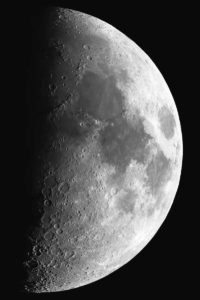
The Moon at First Quarter
The full resolution version of this image is a composite of a mosaic of 24 separate images. Each image was made starting with a film taken and the frames in the image are then stacked together using a program called Registax which enables the information from the best images to be assembled. The image then be sharpened to give a much clearer image than any one of the separate frames in the film.
This technique is replicated for each of the images below but they are are all separate images and not composite mosaics.
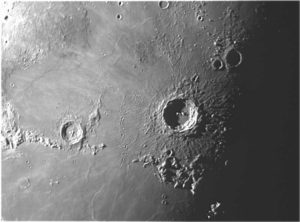
Copernicus
Copernicus is a lunar impact crater located in eastern Oceanus Procellarum. It was named after the astronomer Nicolaus Copernicus. It typifies craters that formed during the Copernican period in that it has a prominent ray system. It may have been created by debris from the breakup of the parent body of asteroid 495 Eulalia 800 million years ago. It is 93 km in diameter.
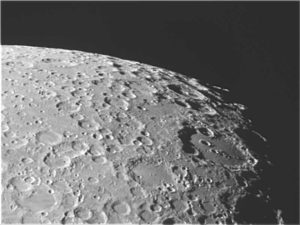
Clavius
Clavius is one of the largest crater formations on the Moon and the second largest crater on the visible near side (very close in size to Deslandres). It is located in the rugged southern highlands of the Moon, to the south of the prominent ray crater Tycho. It is named for the Jesuit priest Christopher Clavius.
Clavius’ location toward the southern limb of the Moon causes it to appear oblong due to foreshortening. Its great size makes it visible to the unaided eye as a prominent notch in the terminator about 1–2 days after the Moon reaches first quarter.
Clavius is one of the older formations on the lunar surface and was likely formed during the Nectarian period about 4 billion years ago. Despite its age the crater is relatively well-preserved.
It has a low outer wall in comparison to its size and is heavily worn and pock-marked by craterlets. It is 231km in diameter and has a depth of 3.5 km.
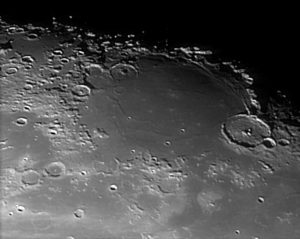
Gassendi
Gassendi is a large lunar impact crater feature located at the northern edge of Mare Humorum. It was named after French astronomer Pierre Gassendi. The formation has been inundated by lava during the formation of the mare, so only the rim and the multiple central peaks remain above the surface.
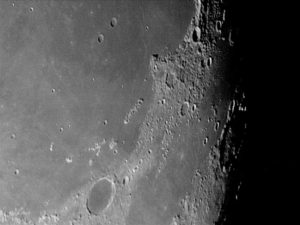
Plato
Plato is a lava-filled lunar impact crater on the Moon. Its diameter is 101 km. It was named after ancient Greek philosopher Plato. It is located on the northeastern shore of the Mare Imbrium, at the western extremity of the Montes Alpes mountain range.
With more practice it should be possible to pick up some few small craters on the otherwise flat interior.
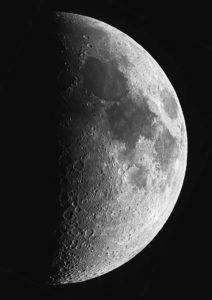
The Moon near First Quarter (42%) (19-04-21)
The full resolution version of this image is a composite of a mosaic of 16 separate images. Each image was made starting with a film taken and the frames in the image are then stacked together using a program called Auto Stakkert 3. This gives better results than using Registax – it seems better at picking the best frames – although Registax can be used to sharpen each image. For a mosaic Auto Stakkert 3 also sharpens to a degree which is perfectly adequate. For processing the individual frames to give closeups of particular craters, then Registax may be better. The exposure was such that the brighter parts away from the terminator were just not washed out. This gives more detail of these brighter areas when printed, although with the resolution decreased for the web this is not easy to see on screen.
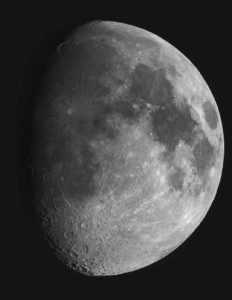
The Moon waxing gibbous (63%) (22-04-21)
The full resolution version of this image is a composite of a mosaic of 33 separate images. Each image was made and processed in the same way as described above for the image created on 19-04-21
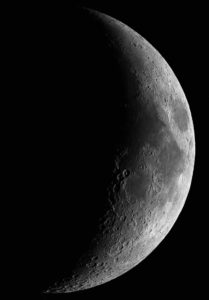
The Moon waxing crescent (23%) (15-06-21)
The full resolution version of this image is a composite of a mosaic of 22 separate images. Each image was made and processed in the same way as described above for the image created on 19-04-21sent
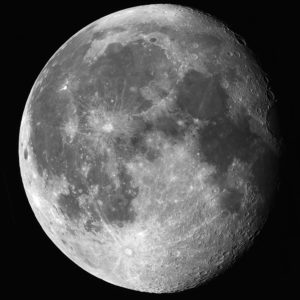
The Moon waning gibbous (94%) (23-09-21)
The full resolution version of this image is a composite of a mosaic of 33 separate images. Each image was made and processed in the same way as described above for the image created on 19-04-21sent
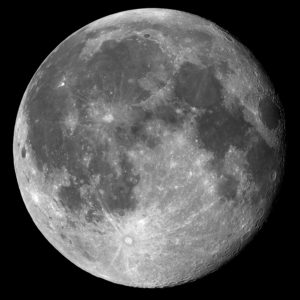
The Moon waning gibbous (98%) (21-11-21)
The full resolution version of this image is a composite of a mosaic of just 6 separate images using the ASI 174 ZWO camera which has a much larger chip. AutoStakkert was used to process each separate mosaic and sharpened in impg which seems easier and better than Registax.